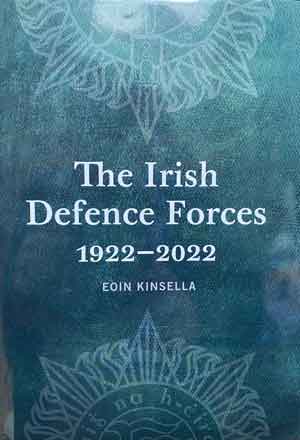EOIN KINSELLA
Four Courts Press in association with the Irish Defence Forces
ISBN 9781801510363
€30
Reviewed by Thomas O’Loughlin
Thomas O’Loughlin is Emeritus Professor of Historical Theology at the University of Nottingham.

‘The history of the Defence Forces can be characterised as an ongoing search for a defined shape and mission’ (p. 249). So, in a massive understatement, writes Eoin Kinsella in his final chapter, bringing their history from the White Paper on Defence (2000) up to the present. Reading the book, we might add that the history—right up to the present—is also characterised by under-resourcing (sometimes to a reckless extent), inattention to poor pay and conditions (especially for the enlisted personnel), and under-appreciation of their role in a democratic state (excepting a vague pride in ‘our army’). This is what makes it a fascinating book. On the one hand, it is as close to an ‘official history’ as Ireland is ever likely to have for its armed forces. It is a celebration of 100 years of continuous service in defence of the state and its constitution, of aiding the civil power, and of service overseas as an integral part of Irish foreign policy. Moreover, while it is a monograph, written fluidly and well, it has also had the benefit of a specially convened editorial board (including Lar Joye, a regular contributor to HI) mainly composed of serving officers. On the other hand, and in stark contrast to the shelves of ‘official histories’ produced by the militaries of other countries, it is a ‘warts and all’ account of those 100 years of service. The atrocities of the Civil War are documented (pp 47–9) and Kinsella acknowledges that ‘violence against women, very often sexual in nature, is one of the more prominent characteristics of the dark underbelly of armed conflicts … [and] recent research has revealed incidence of sexual and gender-based violence … committed by British forces and later both by the National Army and the anti-Treaty IRA’ (p. 49). In a similar vein, he does not shy away from the problems of bullying and harassment in the forces that have come to light in more recent times. The overall result is a balanced account of generous, courageous and excellent service, coupled with notes of the darker moments and the patch, scrimp and ‘make do’ nature of much of the work of that 100 years.
Kinsella’s tale falls into five major divisions: the earliest days and the Civil War; ‘the Emergency’; the advent of UN peace-keeping operations; ‘the Troubles’ (1969–98); and, lastly, the new challenges emerging in the last two decades. Such a sequence is obvious. But note the book’s title: it is the ‘Irish Defence Forces’, not the ‘Irish Army’, and he wants to give due weight to the naval service, the air corps and the reserves (under various names). The result is a book that leaves one shouting ‘But what about …?’ time and again. In fairness, no book of this length can do justice to a century of events; if it is a whistle-stop tour, it is nevertheless a good one. Arguably, also, there is a historical sub-theme showing through on virtually every page: how the Department of Finance penny-pinched and micro-managed expenditure from the very beginning. There is an account of T.K. Whitaker addressing the Military College in the early 1970s to the effect that the government was ‘effectively gambling on peace’ (p. 242). One wonders whether any elected representative would have been so honest or have adopted a parallel approach to their own house insurance.
Three issues, however, should have received more attention. First, there is a case for a special study (the book has several, e.g. the cartoons in An tÓglách, pp 100–3) of the reaction—or the laudable lack of reaction—of the military to the 1932 general election. It does get some attention but mainly in the memoir of Lt. Gen. Gerry McMahon (p. 291), who recounts what his old CO, Seán Lawless, told him that the then chief-of-staff (Gen. Michael Brennan) had told him: ‘We’re a democracy … the citizens have spoken … [and] … voted Fianna Fáil in. So we will do what the government tells.’ Lucky is the democracy with such officers.
Second, while army-related policy, or the lack of it, is given attention, there is not sufficient attention paid to naval policy. Since Ireland is at one end of the Great Circle routes from North America to Europe (a geostrategic position mentioned several times), which is more significant than the Britain-centred notion of the Western Approaches, there is a case that Ireland’s primary defence concerns should be naval. This, however, has never been the case, despite the naval provisions of the 1921 Treaty.
Third, neutrality recurs throughout the book, but while the changed situation of Ireland being part of the EU, with crucial EU assets running through its waters and now potentially at risk ‘when the Russian navy declared its intention to conduct exercises within Ireland’s extended economic zone’, is mentioned (p. 274), a fuller treatment of how it has been a continually shape-shifting reality should have been considered.
Lastly, there is hardly a page without an illustration (many in colour) and these, as historical artefacts, merit attention in themselves. If you have any interest in Ireland’s armed forces or their role in the development of the Irish state, this book is a ‘must read’.
